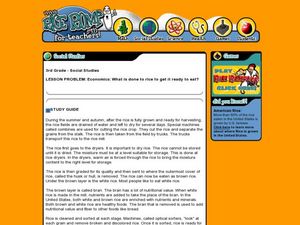Curated OER
Home Living / Daily Living: Shopping List 2
I've done this exercise with my special needs learners more times than I can count. They practice getting ready to shop at the grocery store by identifying items on their shopping list. They match grocery items to the proper department...
Curated OER
Economics: What is done to rice to get it ready to eat?
Third graders create a map showing the journey of rice from the field to the grocery store. In this agriculture lesson, 3rd graders discover and map the process of harvesting and preparing rice to be packaged and shipped to sell to...
Curated OER
Ag Pays
Second graders understand that may jobs relate to agriculture. In this agriculture lesson, 2nd graders role play several agricultural jobs and the goods associated with them. Students may contact a community member with that job.
Curated OER
Seeds, Miraculous Seed
Students investigate relationships between plants and animals and how living things change during their lives. In this life cycle lesson, students split different types of seeds apart to see the beginning life stages of future plants.
Curated OER
Where Do Your Veggies Grow?
Students examine the different ways fruits and vegetables are grown. In this vegetable growth lesson students are presented with the three ways that the vegetation occurs: leaves, roots, or branches. The students group pictures of the...
Curated OER
Career & Technology Education Introduction to Farming: Seeds of Successful Marketing
Students play an agronomy game. In this agriculture lesson plan, students explore modern farming practices pertaining to the cultivation of grains as they play a game that requires them to act as agronomy specialist as they...
Curated OER
Farmers and the Food Connection
Students investigate the process of growing food. In this agricultural lesson, students invite a farmer into their classroom to discuss how they grow and process food. Students participate in learning centers which focus on farming.
Curated OER
Where Does Food Come From?
Distinguish between food and non-food items. Recognize that food is obtained from both plant and animal sources. Identify sources for some common animal foods then construct a simple food path from the farm to the consumer.









